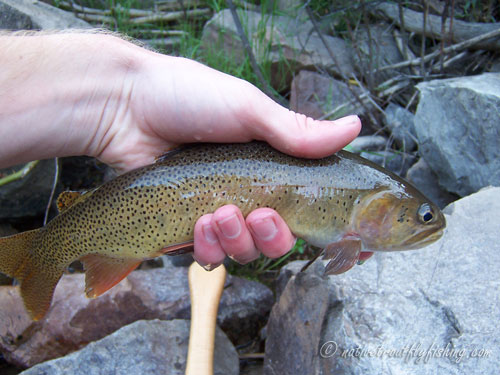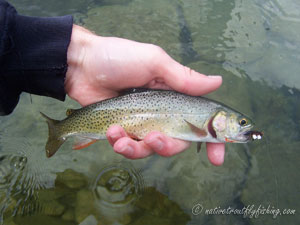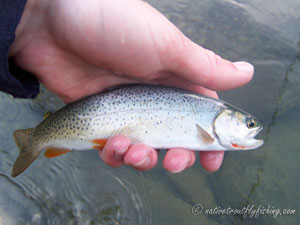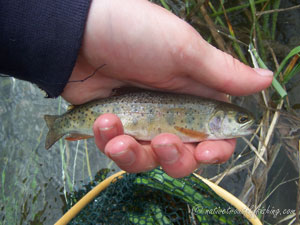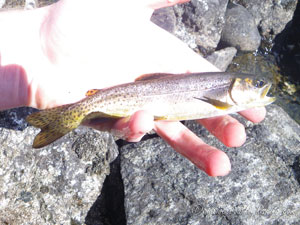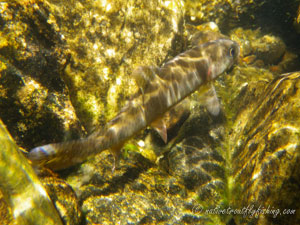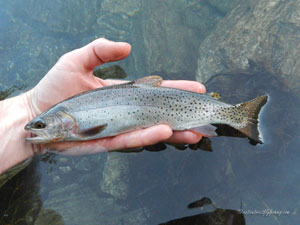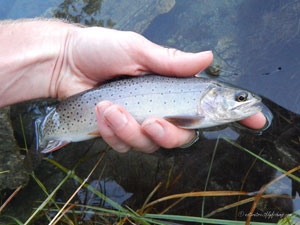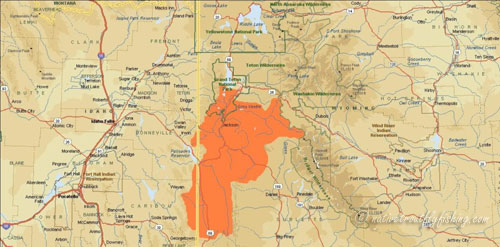Snake River Finespotted Cutthroat
Formerly Oncorhynchus virginalis behnkei
A Snake River Finespotted Cutthroat from a small high gradient stream in the Rockies.
Introduction
The Snake River Finespotted Cutthroat is a morphological form of Yellowstone Cutthroat native to the Snake River drainage between Jackson Lake and the Palisades Reservoir in Wyoming and a small part of Idaho. Above and below this area the predominant fish are large spotted Yellowstone Cutthroat and the fish in the upper reaches of tributaries are often large spotted Cutthroat as well. Prior to the construction of dams on the Snake River at Jackson Lake and Palisades Reservoir, there were no barriers to isolate the two forms of Cutthroat, and the mechanisms leading to this unique spotting pattern are still unclear. Behnke (1992) postulated that the Finespotted form diverged from the large spotted form during the last ice age when it likely was isolated in the Snake River. However, if this is the case, there does not appear to be full reproductive isolation between the two forms and individuals with an intermediate size spotting pattern are relatively common across the range of the Snake River Finespotted Cutthroat (Novak et al. 2005). Additionally, genetic testing has been unable to find significant differences between the large spotted Yellowstone Cutthroat and Snake River Finespotted Cutthroat, suggesting that the two forms are simply unique morphs (Loudenslager and Kitchin 1979, Mitton 2003, Novak et al. 2005, Campbell et al 2018). While Snake River Finespotted Cutthroat were historically considered to be a distinct subspecies of Cutthroat Trout (Behnke 2002, Trotter 2008), current evidence does not support them and suggests that they should be considered part of the Yellowstone Cutthroat subspecies (Campbell et al. 2018, Trotter et al. 2018).
Life History Information
Snake River Finespotted Cutthroat Trout t occur as stream resident, fluvial (stream to river migrant) and adfluvial (stream to lake migrant) populations across their native. Overall, their life history attributes are similar to those of Yellowstone Cutthroat. Like all Cutthroat, Snake River Finespotted Cutthroat spawn in the spring and are able to spawn more than once.
Stream Resident Form
Stream resident populations of Finespotted Cutthroat occur in many spring creeks as well as higher gradient tributaries in the upper Snake River basin. However, it appears that the Snake River Finespotted Cutthroat is not as well adapted to high gradient mountain streams others Cutthroat are, as introductions to this type of habitat have not fared as well as would be expected (Mullan 1975). Additionally, the large spotted form of Yellowstone Cutthroat predominates in the upper reaches of many of the tributary streams within the range of the Snake River Finespotted Cutthroat. Like other Cutthroat, these fish are primarily drift feeders, preying on aquatic and terrestrial invertebrates. In many smaller high gradient tributary streams, growth rates are slow with few fish larger than 10” and the Cutthroat rarely live past age three (Leeseberg and Keeley 2014). However, in the more productive spring creeks may reach 20” (51 cm) (Behnke 2002). Stream resident Finespotted Cutthroat in spring creeks draining to the Salt River typically spawn between April and mid-June and often utilize the same habitat for spawning as fluvial fish (Joyce and Hubert 2004).
Fluvial (River Migratory) Form
The fluvial form is the most widespread life history component of Snake River Finespotted Cutthroat and is found in the Snake River and its larger tributaries between Jackson Lake and Palisades Reservoir. Like the stream resident form, fluvial fish are opportunistic feeders, primarily feeding on aquatic and terrestrial invertebrates until they reach age-3 at which point they readily feed on forage fish. Growth rates for Finespotted Cutthroat is much higher in large mainstem rivers than in smaller tributary streams. These mainstem rivers typically have more abundant prey resources and warmer temperatures into the fall allowing for a longer growing season (Leeseberg and Keeley 2014). In these larger river systems, Finespotted Cutthroat can reach large sizes and fish up to 28” (71 cm) and 12 lbs. (5.4 kg) have been reported (Behnke 2002, Trotter 2008). Fluvial fish typically reach sexual maturity at age-3 to age-4, with about 10% of a given spawning run being composed of age-5 and age-6 repeat spawners (Trotter 2008). River dwelling populations of these trout may spawn within the main channel of the river or make migrations up tributaries to spawn. In the mainstem Snake River spawning success is limited due to high spring flows and sediment loads, which has led the Cutthroat predominately using spring fed tributary streams for spawning, although freestone tributaries and mainstem side channels are also used for spawning (Kiefling 1978, Homel et al. 2015). In the Salt River, Cutthroat utilize a wide variety of habitat for spawning. Of the fish sampled, 37% used freestone tributaries for spawning, 19% used spring creeks and 44% remained in the mainstem river (Sanderson 2007). Fish in the Salt River drainage typically migrate into spring feed tributaries between March and June (Joyce and Hubert 2004) and similar patterns have been seen in the Snake River where spawning has been observed between late-April and mid-July (Gresswell and Homel 2008). In some cases, Finespotted Cutthroat travel long distances to reach their spawning grounds, with migrations up to 63 miles (101 km) being recorded (Homel et al. 2015). Spawning generally occurs in riffles less than a foot deep to provide eggs with enough oxygen to survive. After spawning the mortality rate is about 50% but is offset by a higher than usual survival rate for the eggs (Trotter 2008). The Cutthroat that do survive spawning typically return to the mainstem rivers to forage by August, although 28% of the fish that spawned in spring creeks remained in them throughout the summer (Homel et al. 2015).
Finespotted Cutthroat generally emerge by August and typically utilize slower moving stream margins with cover as habitat until they are around 2” (5 cm), at which point they move into riffle habitat (Hubert and Joyce 2005). Throughout the summer Finespotted Cutthroat typically occupy a relatively small home range, holding in deep riffles and runs and moving upstream or downstream as needed to maximize foraging opportunities. With the fast growth rates in the riverine environment, the Finespotted Cutthroat typically reach a size of 11” to 14" (28 cm to 36 cm) by age-3, about a 20% faster growth rate that that of the Cutthroat in Yellowstone Lake (Trotter 2008). As fall progresses into winter and water temperatures drop, the metabolic rate of these trout drops and feeding, and growth are greatly diminished. Finespotted Cutthroat in the mainstem Snake River and its larger tributaries respond the dropping temperature by seeking out large deep pools for overwintering. They will remain in these pools until temperatures rise about 34 ° F (1 °C), at which point they begin to utilize deep runs as they prepare for their spawning migrations in the spring (Harper and Farag 2004, Sanderson 2007).
Adfluvial (Stream to Lake Migratory) Form
There are a number of lakes and ponds throughout the range of the Snake River Finespotted Cutthroat, which support adfluvial populations, with some of the large ones including Jackson, Jenny and Leigh Lakes. While the fluvial form is relatively well studied and understood, there has been very little work done to understand the life history adfluvial life history form of these trout. However, it is thought that fish exhibit a similar life history to that of other adfluvial Cutthroat populations, being opportunistic feeders that spawn in tributaries to the lakes for the first time at age-3 to age-4. Based on historical records, adfluvial Snake River Finespotted Cutthroat could reach weights of 14 lbs. (6.4 kg) and likely had a maximum age of 6 to 8 years (Trotter 2008). When stocked in lakes outside their native range Finespotted Cutthroat show an incredible ability to adapt to a wide variety of environments and food sources.
Status
Of all the forms of Rocky Mountain Cutthroat, the Snake River Finespotted Cutthroat is perhaps doing better than any of the others. However, while it is still the dominant trout throughout most of its native range, it has still been impacted by a variety of issues ranging from habitat alterations to the introduction of nonnative species. While a large portion of the Finespotted Cutthroat’s native waters are within the boundaries of Grand Teton National Park and Bridger-Teton National, agriculture, logging, and dams have had an impact on much of the habitat that these trout depend on. The construction of Jackson and Palisades dams blocked migration corridors in the Snake River, isolating Snake River Finespotted Cutthroat from the populations upstream and downstream. The construction of the dam on Jackson Lake has also impacted the dynamics of the river system, by reducing flood activity, sediment deposition, natural channel movement resulting a reduction of side channel habitat and gravel that the Cutthroat utilize for spawning (Marston et al. 2005). Much of the critical spawning habitat on spring creeks in the basin has also been altered, due to agriculture. This has often resulted in channelized streams with high sediment lows and a low amount of clean gravel and the riffles that Cutthroat need for spawning. In the Gros Ventre River, Wyoming, which represents some of the best quality habitat for fluvial Snake River Finespotted Cutthroat, irrigation withdrawals often result in a complete loss of viable habitat in the lower river near the confluence with the Snake River during late summer and fall. As result, fish often enter irrigation canals in late summer and fall resulting in about 6% of the population becoming stranded and dying (Eby and Corsi 2009). Luckily many of these issues can be resolved with stream restoration and with efforts currently being made to restore much of the degraded stream habitat throughout the basin the Cutthroat appear to be responding positively.
While nonnative trout species have had a negative impact on Finespotted Cutthroat, the Finespotted Cutthroat have held their own much better than other forms of inland Cutthroat. This may be partially because Finespotted Cutthroat have not hybridized as readily with Rainbow Trout as other Cutthroat do. The primary mechanisms, preventing widespread hybridization are thought to be differences in habitat use and spawn timing between the introduced Rainbow Trout and native Finespotted Cutthroat, with Rainbow Trout spawning prior to or during spring runoff and Cutthroat spawning primarily after spring runoff begins to subside. However, in the lower Gros Ventre River there appears to be a greater overlap in spawn timing between Cutthroat and Rainbow Trout and by early 2000’s approximately 23% of population was hybridized (Kovach and Eby 2006). Additionally, the hybridization hotspot in the Gros Ventre River appeared to be acting as a source of Rainbow Trout genes in the overall Snake River population. While hybridization with Rainbow Trout appears to be occurring at a low frequency within nearly all fluvial populations in the upper Snake River, the frequency of hybrids increases significantly within proximity to the Gros Ventre River confluence (Kovach et al. 2011). To reduce the hybridization threat posed by the lower Gros Ventre River, the Wyoming Game and Fish Department initiated a hybrid suppression program between 2002 and 2016. This program appears to have been successful and the proportion of Rainbow Trout and hybrids in the Gros Ventre River significantly decreased as a result (Kovach et al. 2018). Rainbow Trout are not the only nonnative trout to impact Snake River Finespotted Cutthroat and Brook Trout have been particularly detrimental to stream resident populations. As mentioned in the life history section, Fine Spotted Cutthroat to not appear to be very well adapted to high gradient freestone tributaries and as such Brook Trout generally outcompete the native Cutthroat. As a result, where Brook Trout have been introduced, they often completely replace the native Finespotted Cutthroat. The adfluvial life history form has also been impacted by nonnative trout species and Brown Trout and Lake Trout were introduced to Jackson, Jenny and Leigh lakes, where they have reduced the Cutthroat populations due to predation on juvenile Cutthroat. However, the overall scale of this impact is still poorly understood and despite the presence of these predatory species, adfluvial Finespotted Cutthroat have continued to persist in these lakes.
Today the Snake River Finespotted Cutthroat is the most widely stocked form of Cutthroat and as such are now found well outside of their native range. Part of the success of these introductions is due to their coexistence with numerous prey species in the Snake River, which allows the Finespotted Cutthroat readily adapt to new environments (Behnke 2002). Beyond this, studies have shown that Finespotted Cutthroat also have a greater resistance to whirling disease than Rainbow Trout as well as other forms of Cutthroat (Sipher and Bergersen 2005). This coupled with the fact that they grow fast and can attain relatively large sizes makes them a popular choice with fisheries agencies. Whether or not the Snake River Finespotted Cutthroat is considered a separate subspecies or just a morphological form of Yellowstone Cutthroat, it represents an ecologically and phenotypically unique form of Cutthroat that should be protected into the future.
Description
The trait that makes Snake River Finespotted Cutthroat unique is their spots, which are smaller than those of any other type of trout in western North America. These spots typically look like a sprinkling of pepper and are profusely distributed across the body with the highest concentration towards the caudal peduncle. The coloration of the lower fins on Finespotted Cutthroat typically varies from the peach or rose color of the Yellowstone Cutthroat to a deep red or orange color. Given their genetic similarity, most of their other traits tend to be similar to Yellowstone Cutthroat, with brownish yellow, greenish bronze coloration on the sides. The gill plates are generally an orangish-pink coloration, and they have reddish-orange cutthroat marks below the lower jaw. Juveniles have 9-12 oval parr marks on their sides, which are often retained into adulthood in stream resident populations.
Stream Resident Form
Click on images to view a larger picture
Adfluvial Form
Click on images to view a larger picture
Native Range
A map of the native range of the Snake River Finespotted Cutthroat trout. Data Source: Behnke (2002) and Trotter (2008). Below: A map of the native range of the Yellowstone and Snake River Finespotted Cutthroat Trout.
References
Behnke, R. J. 1992. Native trout of western North America. American Fisheries Society Monograph 6. American Fisheries Society, Bethesda, Maryland.
Behnke, R. 2002. Trout and Salmon of North America. Chanticleer Press, New York.
Campbell, M.R., E.R. Keeley, C.C. Kozfkay, J.L. Loxterman, R.P. Evans and D.K. Shiozawa. 2018. Describing and preserving the diversity of Cutthroat Trout in the Yellowstone, Snake River, and Bonneville Basin. Pages 303-321 in Trotter P, Bisson P, Schultz L, Roper B (editors). Cutthroat Trout: Evolutionary Biology and Taxonomy. Special Publication 36, American Fisheries Society, Bethesda, Maryland.
Gresswell, B. and K. Homel. 2008. Evaluating the movement patterns of Snake River Finespotted Cutthroat Trout in the Snake River below Jackson Lake Dam, Grand Teton National Park. University of Wyoming National Park Service Research Center Annual Report, 31(5): 23-28.
Harper, D.D. and A.M. Farag. 2004. Winter habitat use by cutthroat trout in the Snake River near Jackson, Wyoming. Transactions of the American Fisheries Society 133: 15-25.
Homel, K.M., R.E. Gresswell, J.L. Kershner. 2015. Life history diversity of Snake River Finespotted Cutthroat Trout: Managing for persistence in a rapidly changing environment. North American Journal of Fisheries Management 35(4): 789-801. https://doi.org/10.1080/02755947.2015.1044625
Hubert, W.A. and M.P. Joyce. 2005. Habitat associations of age-0 cutthroat trout in a spring stream improved for adult salmonids. Journal of Freshwater Ecology 20(2): 277-286.
Joyce, M.P. and W.A. Hubert. 2004. Spawning ecology of finespotted Snake River cutthroat trout in spring streams of the Salt River Valley, Wyoming. Western North American Naturalist 64(1): 78-85.
Kiefling, J.W. 1978. Studies of the ecology of Snake River cutthroat trout. Wyoming Game and Fish Department, Fisheries Technical Bulletin 3, Cheyenne, WY.
Kovach, R. and L. Eby. 2006. Hybridization of Snake River Cutthroat in the lower Gros Ventre River. University of Wyoming National Park Service Research Center Annual Report 30(18?): 110-113.
Kovach, R.P., L.A. Eby and M.P. Corsi. 2011. Hybridization between Yellowstone Cutthroat Trout and Rainbow Trout in the upper Snake River basin, Wyoming. North American Journal of Fisheries Management 31: 1077-1087.
Kovach, R.P., R. Al-Chokhachy and T. Stephens. 2018. Proactive Rainbow Trout suppression reduces threat of hybridization in the Upper Snake River basin. North American Journal of Fisheries Management 38: 811-819.
Leeseberg, C.A. and E.R. Keeley. 2014. Prey size, prey abundance, and temperature as correlates of growth in stream populations of cutthroat trout. Enivronmental Biology of Fishes 97(2): 599–614.
Loudenslager, E.J. and Kitchin, R.M. 1979. Genetic similarity of two forms of cutthroat trout, Salmo clarki, in Wyoming. Copeia 4: 673-678.
Marston, R.A., Mills, J.D., Wrazien, D.R., Bassett, B. and Splinter, D.K. 2005. Effects of Jackson Lake Dam on the Snake River and its floodplains, Grand Teton National Park, Wyoming. Geomorphology 71: 79-98.
Mitton, J.B. 2003. Genetic investigation of Snake River and Yellowstone Cutthroat Trout. University of Wyoming National Park Service Research Center Annual Report 27(12): 81-86.
Mullan, J.W. 1975. Condition (K) as indicative of non-suitability of Snake River cutthroat in the management of high gradient, low diversity streams. Proceedings of the Western Association of State Fish and Game Commissioners 55: 267-274.
Novak, M.A., Kershner, J.L. and Mock, K.E. 2005. Molecular genetic investigation of Yellowstone cutthroat and Snake River fine spotted cutthroat trout. Wyoming Game and Fish Commission, Cheyenne, WY.
Sanderson, T.B. 2007. Habitat diversity and access to tributaries are important to adult Snake River cutthroat trout residing in the Salt River, Wyoming. Masters Thesis. University of Wyoming. Laramie, Wyoming.
Sipher, C.R. and Bergersen, E.P. 2005. The effects of whirling disease on growth and survival of Snake River cutthroat and Colorado River rainbow trout fingerlings. Journal of Aquatic Animal Health 17: 353-364.
Trotter, P. 2008. Cutthroat: Native Trout of the West. Second Edition. University of California Press, Berkley, CA.
Trotter, P., P. Bisson, B. Roper, L. Schultz, C. Ferraris, G.R. Smith and R.F. Stearley. 2018. A special workshop on the taxonomy and evolutionary biology of cutthroat trout. Pages 1-31 in Trotter P, Bisson P, Schultz L, Roper B (editors). Cutthroat Trout: Evolutionary Biology and Taxonomy. Special Publication 36, American Fisheries Society, Bethesda, Maryland.
Contact
Feel free to contact me if you have any questions or comments
Snake River Finespotted Cutthroat Trout Links
My Snake River Finespotted Cutthroat Trips
Wyoming Game and Fish Department - Snake River Finespotted Cutthroat Trout
Grand Teton National Park - Fishing
Native Trout Links
California Heritage Trout Challenge
Truchas Mexicanas' - Native Trout of Mexico
Balkan Trout Restoration Group
Trout and Seasons of the Mountain Village - About Japanese Trout
Fly Fishing Blogs
Dave B's Blog: Fly Fishing for Native Trout
The Search for Native Salmonids
Conservation Links
Western Native Trout Initiative
Fly Fishing Links
Fishing Art Links
Americanfishes.com - Joseph R. Tomelleri
